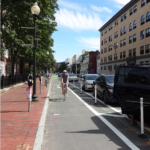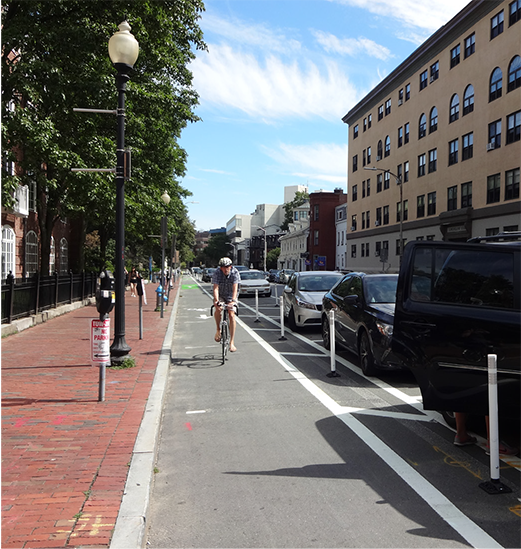
By Dan Eldridge
This August will mark two years since the restriping of Concord Avenue, a project that repainted the lines on the road to switch the positions of the biking and parking lanes.
Separated (sometimes called protected) bike lanes are against the curb and are usually separated from traffic by bollards, islands, or raised platforms: there are no plans to install bollards on Concord Avenue. In each case, a barrier is created so cyclists will encounter fewer vehicles and feel more secure. In the case of Concord Avenue, separation is indicated by painted lines and parked cars only.
Separated bike lanes increase safety for cyclists and decrease risk for drivers by moving the bike lane away from the travel lane. Two of the most common crash types experienced with the previous bike lane configuration were sideswiping from cars to the left in the travel lane and “dooring,” crashing into a door thrown open from a parked vehicle on the right.
By separating the bike lane from the travel lane, these types of crashes are avoided, giving the bike lane user a greater sense of safety and security. This feeling of safety and security is vital to the change in thinking for pedestrian and bicycle lane design. The logic for this is well laid out in chapters 1,2, and 4 of the city of Cambridge’s 2020 Bicycle Plan.
Past research and surveys identified a large group of riders in town referred to as “interested but concerned”; that is, they would like to cycle more but feel too vulnerable biking in the older lane configuration between traffic and parked cars. When asked what would make them feel safer, the number one response was separation.
You don’t have to look far to see other towns and cities implementing protected bike lanes at every opportunity. While Boston and Cambridge lead the way, neighboring communities follow suit. A study of a similar project on Cambridge Street in Cambridge found that bicycle traffic increased between 21% and 59% depending on the time of day after adding a protected lane.
A more secure cyclist rides more and helps alleviate traffic congestion by leaving their car in the driveway. The 2020 Cambridge Bicycle Plan states that increasing the construction of safer bike facilities goes hand in hand with increased ridership. Ridership in Cambridge is up four times what it was in 2002. The Massachusetts Department of Transportation guidance on separated bike lanes also documents the standardization of separated bike lanes.
How Concord Avenue got bike lanes
The Concord Avenue project began when the Traffic Working Group identified the need for an enhanced Middle and High School bicycle lane while planning for the new campus. In 2021, the town engineer asked the consulting/design firm Nelson/Nygaard to plan a separated lane based on using parked cars as the separating buffer, and the Transportation Advisory Committee (TAC) was asked to hold a public forum. Following two sessions, the TAC voted to recommend favorable action on the plan and sent it to the Select Board.
The Select Board delayed acting on the recommendation and asked the TAC to hold more public comment sessions to make alterations and include additional public feedback. The TAC held several design reviews at its monthly meetings through the fall of 2021 and another public forum in February 2022. The TAC again voted to recommend favorable action and sent the plan back to the Select Board. This time, the Select Board voted favorably, and the Department of Public Works repainted the roadway the following summer.
Reception to the new lanes has been generally positive. While the town does not track usage, the general consensus has been that the number of people using the new lanes and bicycle parking available at the new Middle and High School has significantly increased. Residents have expressed a much greater feeling of safety with the new configuration, with many now feeling comfortable riding with their young children on Concord Avenue. There has also been a noticeable traffic calming effect, with abutters commenting on the reduced traffic speed and noise that has resulted from narrowing the travel lane.
TAC plays a big role in project planning
A big part of this project was the TAC working with Town Engineer Glenn Clancy to gather public feedback and make recommendations to help address concerns. When the town seeks public input about its roadways and transportation infrastructure, those issues often end up before the TAC, where they can be discussed publicly and with input from those interested. All TAC meetings are open to the public and are posted in advance on the TAC’s page on the town of Belmont website. Minutes of previous meetings can also be found there.
In addition to attending TAC meetings, residents can raise issues regarding traffic, transportation, and safety with Clancy. The process for raising issues is laid out in the town’s traffic calming and crosswalk policies.
The town continues to explore ways to improve pedestrian and bicycling infrastructure. While the Belmont Community Path is the most ambitious project, Phase 1 is still years away from construction start, anticipated for 2026. Other projects in the works are designating specific bike routes through town, reworking Grove Street with an eye on traffic calming and better bike lanes, and adding traffic-calming features to White Street.
Belmont also continuously evaluates its crosswalks, recently adopting the aforementioned crosswalk policy. Currently, Clancy is exploring options to improve the crosswalks on Concord Avenue, specifically near the Middle and High School.
If you are interested in learning more, please contact any current TAC member or the town engineer with anything specific you would like addressed. While we are pleased with what we have accomplished so far, we are all well aware of how much work remains to make Belmont a safer, easier, and more inclusive place to get around.
Dan Eldridge is vice-chair of the Belmont Transportation Advisory Committee.



Sorry, the comment form is closed at this time.